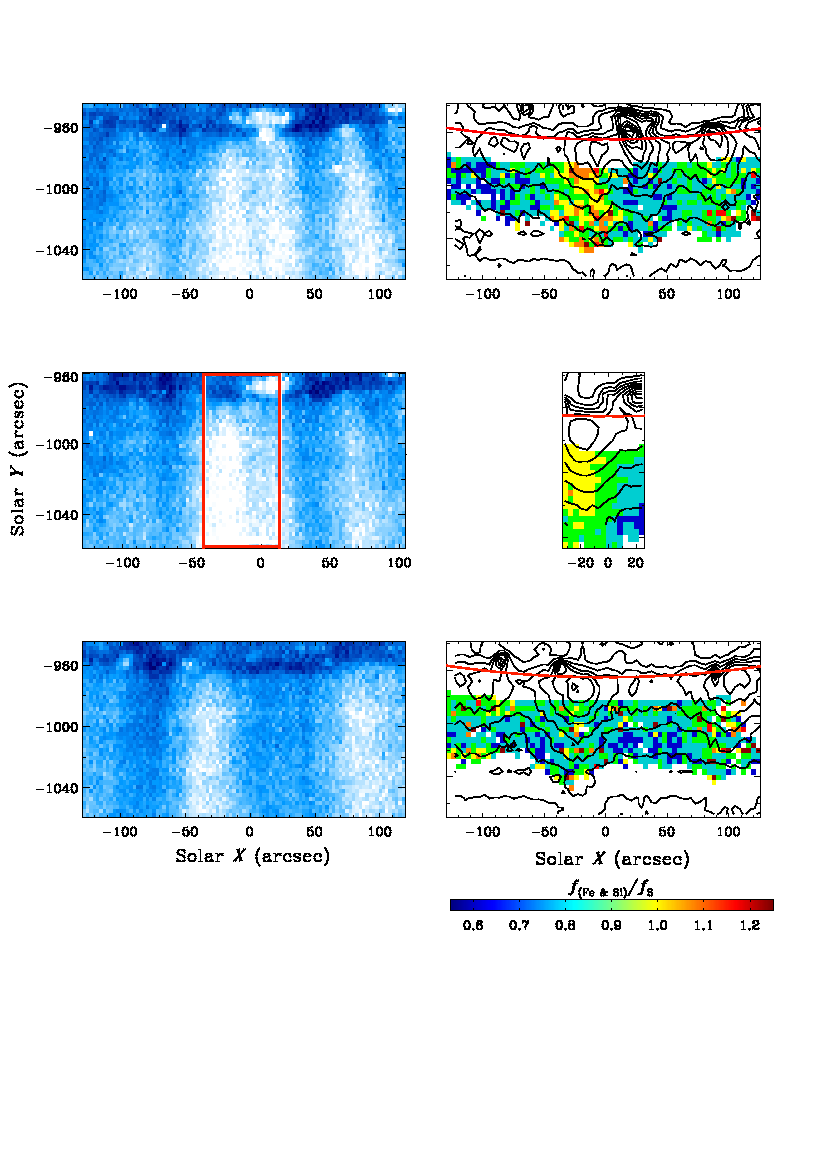Plumes are relatively bright, narrow structures in coronal holes that extend along open magnetic
field lines far out into the corona. Plumes are generally denser and cooler than their surroundings and are
likely heated at the base. Despite many studies carried out in white light and
extreme ultraviolet (EUV), there are still many open questions about plumes, such as their formation
mechanism and their possible contribution to the fast solar wind.
Measurements of elemental abundances can help to resolve these questions. Extensive coronal
measurements show abundance anomalies in the solar corona, in which elements with a low first
ionization potential (FIP) < 10 eV are enhanced relative to the high FIP elements. The FIP
bias for an element is defined as the ratio of its coronal to photospheric abundance. Remote
sensing spectroscopic measurements show that interplume regions have a photospheric composition.
In contrast, the elemental composition of plume material is still unclear; previous spectroscopic
measurements have reached contradictory results as to whether the elemental abundances in plumes
are the same as or different from interplume regions.
To address this issue, we have used a set of Hinode/Extreme Ultraviolet Imaging Spectrometer
(EIS) observations off-limb at the Southern pole. The observations started on 2007 March 13, using the 1" slit,
and spanned an ~24 hour period. SOHO/Extreme Ultraviolet Imaging Telescope (EIT)
observations in the 171 Å bandpass, corresponding to our three data sets, presented in the left
column of Figure 1, show the presence of various plumes within the field of view. These off-limb
rasters are ideal for our study because they present a well developed polar coronal hole and contain
insignificant contamination from quiet Sun plasma.

Figure 1: Left column: Maps of the measured intensity for each of the three data sets as seen by
SOHO/EIT in the 171 Å channel. The red box on the middle pannel outlines the position of the EIS raster for this data set.
The solar limb is highlighted by the white line. Right column: Maps of the FIP-bias ratio ƒ(Fe & Si) / ƒS for each data set. The black contours correspond to the intensity
measured using the Fe X 184.54 Å line. The red line displays the solar limb.
Based on a differential emission measure (DEM) analysis, we assess the chemical composition
of the observed plumes and interplumes. We derived the DEM using lines from the low-FIP
elements Fe and Si. Based on this Fe & Si DEM, we then computed the predicted intensities of the
S VIII 198.55 Å line. S is a moderate FIP element, so its coronal abundance may differ from that
of Fe and Si. By comparing the predicted and observed S line intensities, we can derive the ratio
of the FIP biases, ƒ
(Fe & Si) / ƒ
S.
Figure 1 (right column) shows the ƒ
(Fe & Si) / ƒ
S FIP-bias-ratio maps for the three data sets. We
find that interplume gas exhibits a constant FIP-bias ratio over the duration of the observations. Conversely, over the ~24 hour observation
period the time evolution of the FIP-bias ratio differs dramatically from plume to plume. The initially brightest plume at X ~15",
which appears to originate from a bright point, rapidly fades away, becoming an interplume region, and does not show
any evolution in its FIP-bias ratio, with an initial FIP-bias ratio similar to that of the interplume
regions. This is to be contrasted with the behavior of the other three plumes. The plume initially at
X ~ -15" shows the largest initial FIP-bias ratio, but the value decreases over time, approaching,
though not reaching, that of the interplume gas. These changes occur despite the nearly constant
brightness and density of this structure. The plume initially at X ~ -80" shows a small increase
in its FIP-bias ratio over time, increasing from a value initially close to that of interplume gas.
Lastly, the plume initially at X ~85" exhibits a nearly constant FIP-bias ratio, which is slightly
higher than that of the interplume gas.
We find that some plumes do show different elemental abundances relative to interplumes.
Moreover, the abundance anomalies in plumes are time dependent. This variation between plumes
and over time within a plume may explain the discrepancies among previous measurements. Our
work on plume and interplume elemental composition may also enable in situ measurements to
answer the longstanding question of whether plumes contribute to the fast solar wind.
References
Guennou, C., Hahn, M., & Savin, D. W. 2015, ApJ, 807, 145


